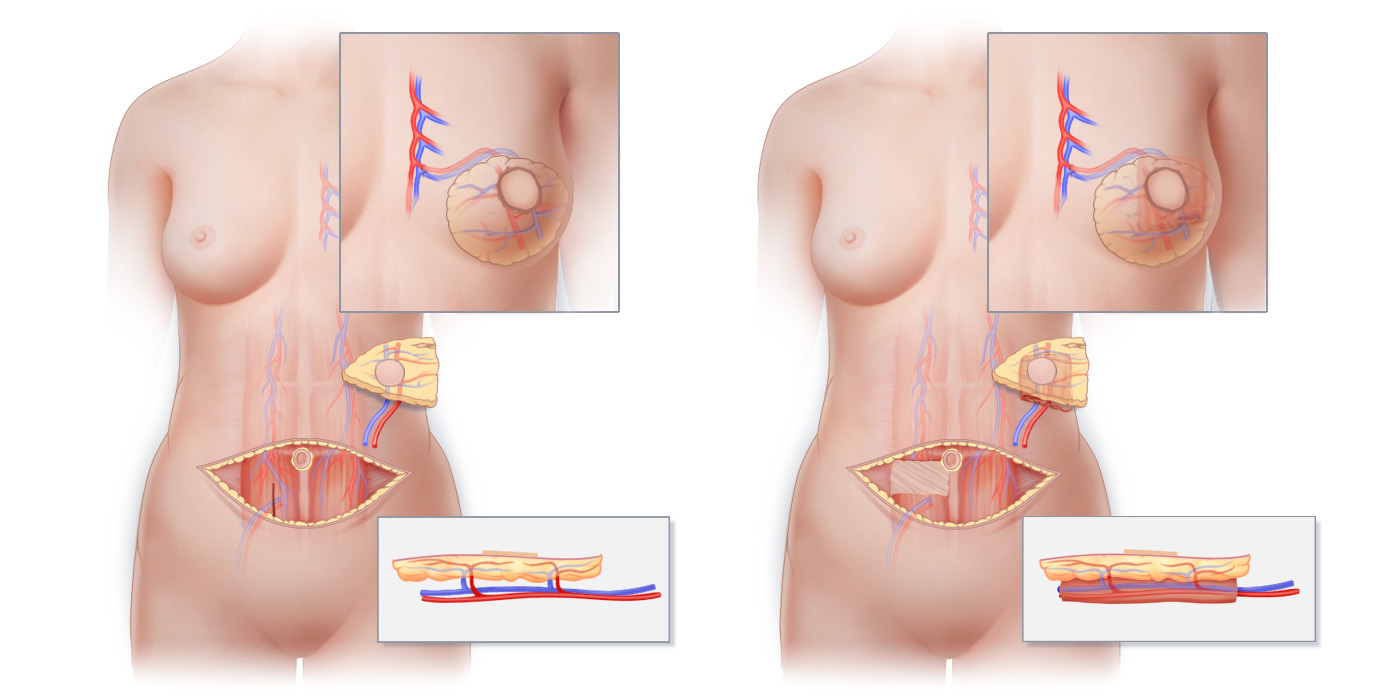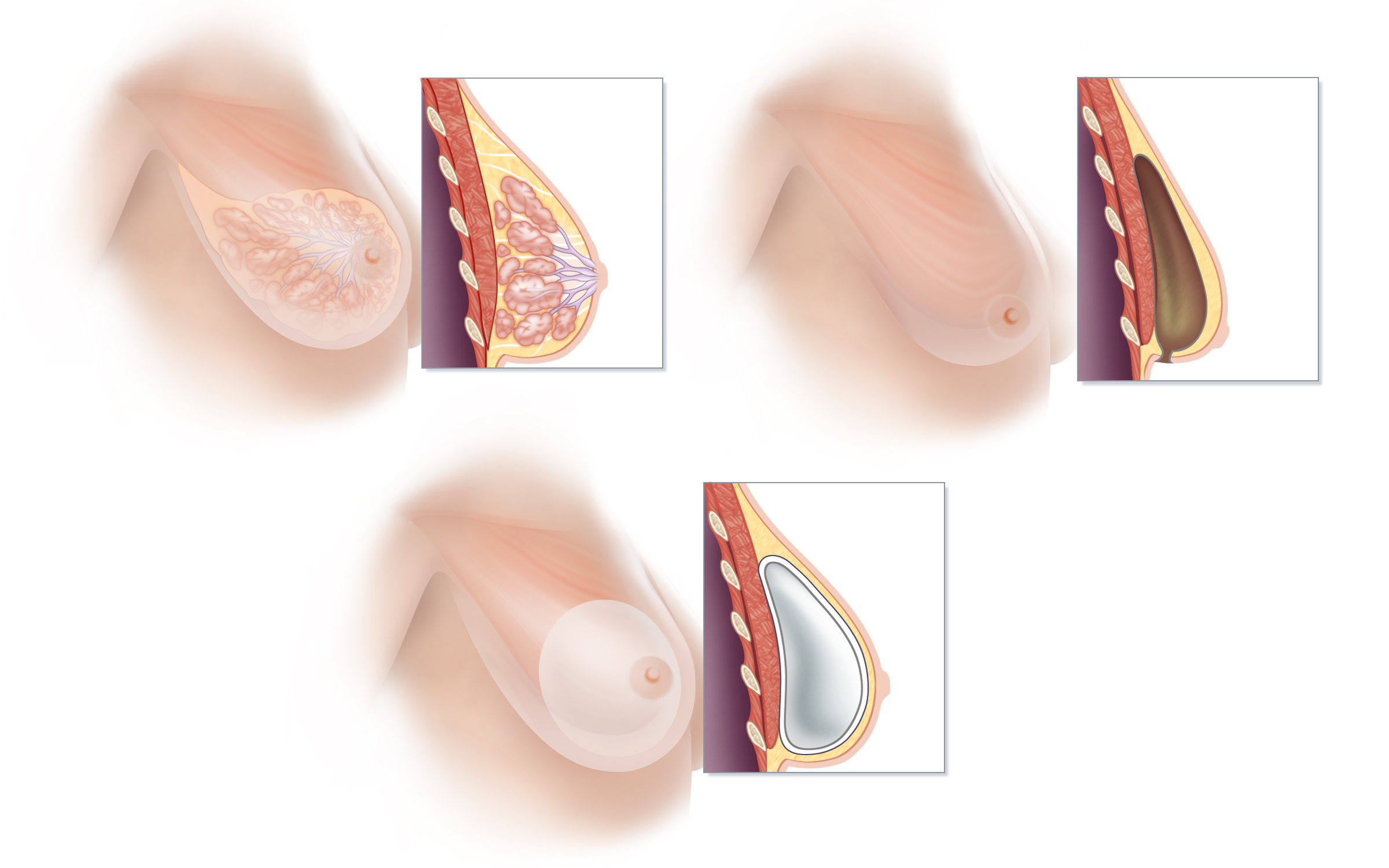Breast Reconstruction After Mastectomy
Breast Reconstruction After Mastectomy
All breast reconstruction procedures fall into one of two broad categories:
- Breast reconstruction using natural tissue from your own body
- Breast reconstruction using breast implants
Natural tissue generally provides the most natural-appearing (and feeling) as well as most durable type of breast restoration. Reconstruction with breast implants, however, may be preferred by some women, especially if they want to avoid a scar on a location other than the breast/s.
The surgeons of our Advanced Reconstructive Surgery Group specialize breast reconstruction surgery.
STATE-OF-THE-ART APPROACHES TO BREAST RECONSTRUCTION
NATURAL TISSUE
Living tissue that is surgically relocated from one part of the body to another is called a “flap.” The most advanced methods of natural-tissue breast reconstruction, known collectively as perforator flaps, use natural tissue to restore a breast without compromising a woman’s muscles in the process. These procedures can be performed with a minimal amount of pain. They typically result in a reconstructed breast that is warm, soft and forever part of a woman’s body. Our practice has roughly a 99.5% success rate for these procedures. Because perforator flaps do not remove muscle, these procedures are now considered by many experts to be the gold standard for natural-tissue breast reconstruction.

One of the most important factors differentiating the various methods of natural-tissue breast reconstruction from one another is whether or not muscle is surgically removed from the site from which the tissue is borrowed. Perforator flaps such as the deep inferior epigastric perforator flap (DIEP flap) preserve muscle, while musculocutaneous flaps such as the free transverse rectus abdominus myocutaneous flap (free TRAM flap) sacrifice important muscles. (A) Preparation of a DIEP flap takes place without removing any muscle from the abdomen. (B) Preparation of a free TRAM flap requires removal of rectus abdominus muscle from the abdomen. It is important to note that muscle does not ever grow back, so operations that remove muscle produce life-long change. Lower insets show flaps in cross-sectional view.

One of the most important factors differentiating the various methods of natural-tissue breast reconstruction from one another is whether or not muscle is surgically removed from the site from which the tissue is borrowed. Perforator flaps such as the deep inferior epigastric perforator flap (DIEP flap) preserve muscle, while musculocutaneous flaps such as the free transverse rectus abdominus myocutaneous flap (free TRAM flap) sacrifice important muscles. (A) Preparation of a DIEP flap takes place without removing any muscle from the abdomen. (B) Preparation of a free TRAM flap requires removal of rectus abdominus muscle from the abdomen. It is important to note that muscle does not ever grow back, so operations that remove muscle produce life-long change. Lower insets show flaps in cross-sectional view.
BREAST IMPLANTS
For women who opt to have breast reconstruction using breast implants, it is now sometimes possible to place a breast implant directly into the space created by the mastectomy, just underneath the skin of the breast. While this state-of-the-art approach is not suitable in every situation, it is often preferred over the traditional approach of tissue expander/breast implant reconstruction that involves surgical disruption of the muscles of the chest that can be painful in the short term, and may compromise muscle function and be uncomfortable in the long term. Unfortunately, breast implants generally do not last forever. The advantages of this quicker initial surgery should be weighed against the frequency with which later complications occur, such as capsular contracture, implant rupture and a high rate of unplanned re-operation.

We perform a state-of-the-art method of implant reconstruction that preserves the pectoralis muscle of the chest in its natural form and places a breast implant into the same location that breast tissue is found (A). This method, known as prepectoral breast implant reconstruction, takes advantage of the space created by the removal of breast tissue at the time of mastectomy (B) to achieve a reconstruction without disrupting the pectoralis muscle. By placing a silicone-filled implant wrapped in specialized acellular dermal matrix directly into the space that results at the time of mastectomy (C), weakness and discomfort associated with traditional breast implant reconstruction (in which an implant is placed beneath the pectoralis muscle) is avoided. Additionally, with prepectoral breast implant reconstruction, the unsightly movement of implants known “animation deformity,” frequently seen with physical activity in women who have had traditional breast implant reconstruction, is avoided.

We perform a state-of-the-art method of implant reconstruction that preserves the pectoralis muscle of the chest in its natural form and places a breast implant into the same location that breast tissue is found (A). This method, known as prepectoral breast implant reconstruction, takes advantage of the space created by the removal of breast tissue at the time of mastectomy (B) to achieve a reconstruction without disrupting the pectoralis muscle. By placing a silicone-filled implant wrapped in specialized acellular dermal matrix directly into the space that results at the time of mastectomy (C), weakness and discomfort associated with traditional breast implant reconstruction (in which an implant is placed beneath the pectoralis muscle) is avoided. Additionally, with prepectoral breast implant reconstruction, the unsightly movement of implants known “animation deformity,” frequently seen with physical activity in women who have had traditional breast implant reconstruction, is avoided.
Connecticut Breast Reconstruction New York Breast Reconstruction
Breast reconstruction surgery can restore the shape, size and appearance of a woman’s breast following mastectomy or lumpectomy. New kinds of treatment and improved reconstructive surgical techniques mean that women who have breast cancer today have more and better options than ever before. Dr. Greenspun is a top breast reconstruction specialist; his offices are located in Connecticut and New York.
» Contact us for information about breast reconstruction in Greenwich, Connecticut, New York and New Jersey.
To learn more about breast implant reconstruction, click here
To learn more about natural tissue reconstruction, click here

